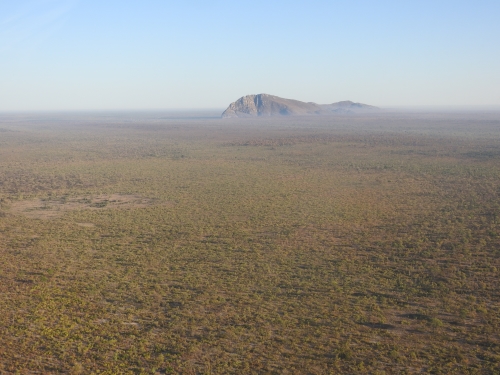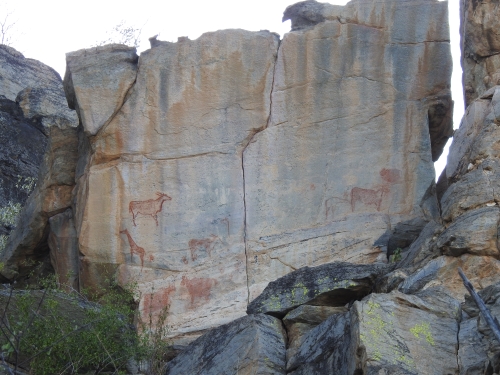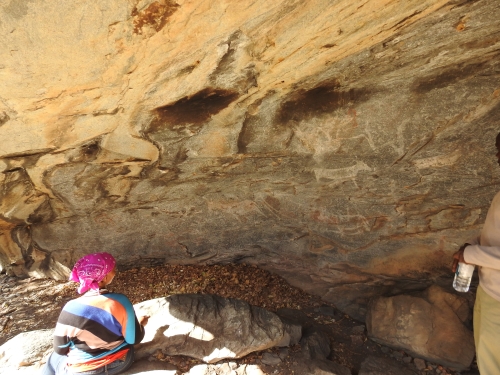Blog WHS Visits
WHS #699: Tsodilo
Tsodilo currently ranks 953rd out of 1092 on our list of most visited WHS. That low position has at least 2 reasons: it isn’t a well-known site among the general travel audience and it lies somewhat out of the way from Botswana’s main tourist zone between Maun and Kasane. Those difficult logistics almost beat me as well: the only logical route is when you’re coming from Namibia (the Caprivi Strip) with a rental car like Svein & Randi did last month - then you’ll pass it. However, I had no car and was staying in Maun. The company that I booked my safari with proposed to fly me north and put me in a “fishing lodge” for 2 nights – I could take a day tour from there. But I found a tantalizing alternative: a half-day tour by helicopter from Maun to Tsodilo!!
So on a Saturday morning I reported at Maun airport at 6.30 am for my flight up there. They fly with small helicopters, there’s only room for the pilot and 3 guests. It takes about 1 hour and 15 minutes to get to the Tsodilo Hills. The pilot had to yell a few times to wake up Maun air traffic control – we were the first to leave just after sunrise. The flight was relaxing, flying rather low over first the farmlands with cattle and then the Okavango Delta. We saw some wildfires but no water at all in this southwestern part of the delta. Only elephants could be seen moving around.
Already from dozens of miles away the Tsodilo Hills appear on the horizon. The rest of the landscape is very flat and these hills do stand out as a beacon. There are some nasty winds blowing around them and the pilot wondered aloud why the helipad was constructed at the backside of a mountain. But we made it to the ground safe and sound. At the Tsodilo airstrip a jeep from Nxamaseri Lodge was waiting for us. The driver had driven all the way from the Okavango panhandle over an hour away just to transport us 10 minutes to the entrance of Tsodilo, from the so-called 'Male' hill to the 'Female' hill. Important as well though he brought the food for brunch - there are no amenities at Tsodilo (except toilets).
We (the pilot, the driver, myself and a local guide) however first started out on the Rhino Trail. This is the most commonly chosen path along the major rock art, at the foot of the ‘Female’ hill. At just after 8 am, it was still very cool especially on the shaded side. The path is mostly flat and sandy. The panels with rock paintings are signposted with numbers and easy to see. Some are so close to the path that you could touch them (it does damage them so that’s forbidden and also one of the reasons you can only walk around with a local guide). Others are higher up the impressive coloured rocks of this mountain. It is recommendable to bring a camera with a good zoom, as that’s the only way that you can see details like hand paintings.
The trail also shows some of the caves the San hunters would hide in. A large one was used as a kind of refrigerator, to store meat and cool water in ostrich egg shells. In the early morning sand we also saw footprints of leopard and kudu – a clear sign that the wild animals depicted at the rock paintings are still out there. The oddest rock art panel is the one with a penguin (could be a duck as well) and a whale. They are said to have been made by San that came from the Namibian coast.
Back at the entrance I had a quick look in the museum. Besides the paintings the Tsodilo site is also known for its archeological findings: at the top of the mountain there were two settlements. Lots of fish bones and ostrich eggs have been discovered, but they all seem to have been whisked away to museums elsewhere. Only a few pots are shown now at the site museum, probably because the safety of the objects could not be guaranteed here. We finished our tour at the picnic site, among the squirrels, with a well-deserved brunch and cool drink.
Els - 19 May 2019


